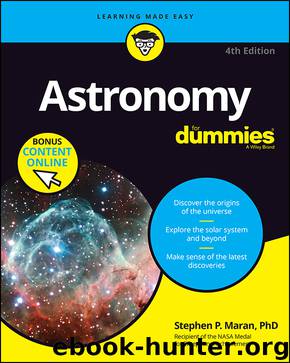Astronomy for Dummies by Maran Stephen P.;

Author:Maran, Stephen P.;
Language: eng
Format: epub
Publisher: John Wiley & Sons, Incorporated
Published: 2017-08-28T00:00:00+00:00
The disk of Uranus has a pale green tint; you can make out the disk with a high-power eyepiece when viewing conditions are good. (Chapter 3 has more about telescopes and eyepieces.) You can detect the motion of Uranus by making a sketch of its relative position among the stars in the field of view. For this purpose, use a low-power eyepiece so the field of view is larger and more stars are visible. Look again in a few hours or on the following night, and sketch again.
You may glimpse a few of the biggest of Uranus’s 27 known moons with large amateur telescopes, but they’re better suited for study with powerful observatory telescopes. Uranus’s dark rings are detectable with the Hubble Space Telescope and in images made with very large telescopes on Earth, but you can’t see them with amateur instruments.
You can see the Hubble Space Telescope images of Uranus and its rings at hubblesite.org/images/news/86-uranus. You can browse images of Uranus, its moons, and the rings from the Voyager 2 space probe at photojournal.jpl.nasa.gov, the Planetary Photojournal website; just click on the labeled picture of Uranus there. (Voyager 2 is the only spacecraft that visited Uranus.)
Download
This site does not store any files on its server. We only index and link to content provided by other sites. Please contact the content providers to delete copyright contents if any and email us, we'll remove relevant links or contents immediately.
| Aeronautics & Astronautics | Astronomy |
| Astrophysics & Space Science | Comets, Meteors & Asteroids |
| Cosmology | Mars |
| Solar System | Star-Gazing |
| Telescopes | UFOs |
Tools of Titans by Timothy Ferriss(8213)
Turbulence by E. J. Noyes(7935)
Secrets of Antigravity Propulsion: Tesla, UFOs, and Classified Aerospace Technology by Ph.D. Paul A. Laviolette(5309)
Astrophysics for People in a Hurry by Neil DeGrasse Tyson(5130)
Room 212 by Kate Stewart(5035)
Design of Trajectory Optimization Approach for Space Maneuver Vehicle Skip Entry Problems by Runqi Chai & Al Savvaris & Antonios Tsourdos & Senchun Chai(5011)
Pale Blue Dot by Carl Sagan(4907)
The David Icke Guide to the Global Conspiracy (and how to end it) by David Icke(4624)
A Journey Through Divination and Astronomy by Publishing Pottermore(4341)
Goodbye Paradise(3724)
Apollo 8 by Jeffrey Kluger(3635)
COSMOS by Carl Sagan(3553)
Losing the Nobel Prize by Brian Keating(3498)
The Five People You Meet in Heaven by Mitch Albom(3474)
How to Read Water: Clues and Patterns from Puddles to the Sea (Natural Navigation) by Tristan Gooley(3406)
Brief Answers to the Big Questions by Stephen Hawking(3369)
How to Read Nature by Tristan Gooley(3249)
The Order of Time by Carlo Rovelli(3144)
A Brief History of Time by Stephen Hawking(2959)
